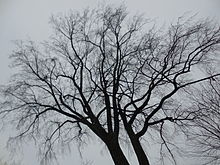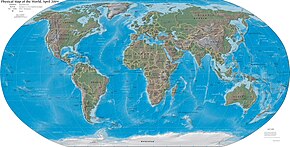Red and green trees in spring
In temperate and subpolar regions, four calendar-based seasons (with their adjectives) are generally recognized: spring (vernal), summer (estival), autumn (autumnal) and winter (hibernal). In American English and Canadian English, fall is sometimes used as a synonym for both autumn and autumnal. Ecologists often use a six-season model for temperate climate regions that includes pre-spring (prevernal) and late summer (serotinal) as distinct seasons along with the traditional four.
A tree in winter
The six ecological seasons
The four calendar seasons, depicted in an ancient Roman mosaic from Tunisia.
An Empire style chariot clock depicting an allegory of the four seasons. France, c. 1822.
In some parts of the world, special "seasons" are loosely defined based on important events such as a hurricane season, tornado season, or a wildfire season.
ရာသီဆိုသည်မှာ နေ(တနင်္ဂနွေဂြိုဟ်)၏ သွားလမ်းအတိုင်း တစ်ပတ်ပြည့်အောင် လှည့်ပတ်သွားလာသော အချိန်ကာလကို အပိုင်းအစု ခွဲခြားသတ်မှတ်ထားသော အချိန်ပိုင်း ဖြစ်သည်။ နေသည် ရက်ပေါင်း ၃၆၅ ၁/၄ ရက်ကြာမှ ရာသီစက်ကို တစ်ပတ်ပတ်မိရာ၊ ထိုကာလကို ၁၂ ပိုင်းပိုင်း၍ တစ်ပိုင်းကို တစ်ရာသီဟု ခေါ်သည်။ တစ်ရာသီတွင် နက္ခတ်ခရီးအားဖြင့် ကိုးပါဒ်၊ သို့မဟုတ် (လေးပါဒ်သည် နက္ခတ်တလုံးနှင့် ညီမျှသဖြင့်) နှစ်လုံးတစ်ပါဒ် လှည့်ပတ်သည်။ နေတစ်ပတ် ပတ်ချိန်ကို တစ်နှစ်ဟု ခေါ်သည်။
နေတစ်ပတ် ပတ်ချိန်၏ ကာလအပိုင်းအခြားကို ၁၂ ပိုင်း ခွဲစိတ်မှတ်သားရာတွင် အကြမ်းအားဖြင့် လပြည့်ခြင်းသည် ၁၂ ကြိမ်ရှိ၍ လကွယ်ခြင်းသည် ၁၂ ကြိမ်ရှိသဖြင့် လဆန်းစမှ လကွယ်အထိ ကာလကို တစ်ပိုင်း၊ သို့မဟုတ် တစ်လအဖြစ် သတ်မှတ်ကြသည်။ ၂၆၅ ၁/၄ ရက်ကို ၁၂ ပိုင်း အညီအမျှ မပိုင်းချေ။ ထို့ကြောင့် လအားဖြင့် တစ်နှစ်လျှင် ရက်စုံ(ရက် ၃ဝ)ခြောက်လနှင့် ရက်မစုံ (၂၉)ရက် ခြောက်လဟူ၍ ရက်ပေါင်း ၃၅၄ ရက်သာ ရှိသဖြင့် နေသွားအတိုင်း တစ်နှစ်သည် လဆန်းသည်မှ ကွယ်သည်အထိ လဝန်း လှည့်ချိန် ၁၂ ကြိမ်ထက် ၁၁ ၁/၄ ရက် ပိုနေသည်။ ထိုပိုသောရက်များကို စုမှတ်၍ သုံးနှစ်လျှင် တစ်ကြိမ် ဝါကြီးထပ်၊ ဝါငယ်ထပ် စသည်ဖြင့် ဒုတိယဝါဆိုလဟူ၍ တစ်လတိုးဖြည့်ကာ ဖြည့်သွင်း ခုနှိမ်ရသည်။ ဝါကြီးထပ်လျှင် လေးလရက်စုံ သတ်၍ ကဆုန်၊ နယုန်ပထမဝါဆို၊ ဒုတိယဝါဆို လေးလလုံး ရက်ပေါင်း ၃ဝ စီ ထားသည်။ ဝါငယ်ထပ်လျှင်မူ နယုန်လအဖို့ ရက်မစုံ ၂၉ ရက် ထားမြဲ ဖြစ်သည်။ထိုနည်းဖြင့် နေလှည့်ချိန်တစ်နှစ်နှင့် လဆန်းအချိန်မှ ကွယ်ချိန် အထိ ၁၂ လကို တစ်ပြေးတည်း ညီမျှသွားစေသည်။
ဆယ့်နှစ်လ၊ သို့မဟုတ် ဆယ့်နှစ်ရာသီကို မြန်မာအမှတ်အသား အားဖြင့် တန်ခူး၊ ကဆုန်၊ နယုန်၊ ဝါဆို၊ ဝါခေါင်၊ တော် သလင်း၊ သီတင်းကျွတ်၊ တန်ဆောင်မုန်း၊ နတ်တော်၊ ပြာသို၊ တပို့တွဲနှင့် တပေါင်းဟူ၍ အစဉ်လိုက် အမည်မှည့်ခေါ်ထားသည်။
ဗေဒင်အလိုအားဖြင့်မူ လဆန်းမှလကွယ်ချိန်ကို တစ်ရာသီ မမှတ်ဘဲ၊ နက္ခတ် ၂၇ လုံး လှည့်ပုံအလိုက် နက္ခတ်လှည့်ချိန် နှစ်လုံးတစ်ပါဒ်ကာလကို တစ်ရာသီဟု မှတ်ယူသည်။ ထိုကြောင့် လဆန်းမှ လကွယ်အထိဖြစ်သော မြန်မာလနှင့် နက္ခတ်တစ်ခွင် တစ်ခွင်၌ မကူးပြောင်းမီ တည်ချိန်ဖြစ်သော ဗေဒင်အလို ရာသီသည် တစ်ထပ်တည်း မကျချေ။ ရက်အများဆုံး ထပ်ဆုံတတ်သည့် ရာသီအလိုက် မြန်မာလများကို ဗေဒင်ရာသီနှင့် ယှဉ်တွဲ၍ တန်ခူးကို မိဿ၊ ကဆုန်ကို ပြိဿ၊ နယုန်ကို မေထုန် စသည်ဖြင့် မှတ်သားကြရသည်။ မြန်မာလကို ဝေါဟာရလဟု ခေါ်၍ ဗေဒင်နက္ခတ်အလိုအားဖြင့် သတ်မှတ်သောလကို ရာသီလဟု ခေါ်သည်။
အနောက်နိုင်ငံသားတို့၏ အလိုအရ သဘာဝအလျှောက် အပူအအေးနှင့် နေ့တာညတာ ပြောင်းလဲခြင်းများကို လိုက်၍ တစ်နှစ်တည်းဟူသော အချိန်ကို နွေကူးရာသီ၊ နွေရာသီ၊ ဆောင်းကူးရာသီ၊ ဆောင်းရာသီဟူ၍ ရာသီဥတု လေးပိုင်းခွဲခြား ထားသည်။ မြောက်ကမ္ဘာလုံးခြမ်းတွင် မတ်လ၊ ဧပြီလနှင့် မေလတို့သည် နွေကူး ရာသီလများဖြစ်၍ ဇွန်၊ ဇူလိုင်နှင့် ဩဂုတ်လများသည် နွေလများ ဖြစ်ကြသည်။ ဆောင်းကူးရာသီလများတွင် စက်တင်ဘာ၊ အောက်တိုဘာနှင့် နိုဝင်ဘာလများ ပါဝင်၍ ဒီဇင်ဘာ၊ ဇန်နဝါရီနှင့် ဖေဖော်ဝါရီလများသည် ဆောင်းလများ ဖြစ်ကြလေသည်။ တောင်ကမ္ဘာလုံးခြမ်းရှိ ရာသီဥတုများမှာ မြောက်ကမ္ဘာလုံးခြမ်းရှိ ရာသီဥတုများနှင့် လုံးဝဆန့်ကျင်လေသည်။
ရာသီဥတုအပြောင်းအလဲဖြစ်ရသည်မှာ ကမ္ဘာကနေကို ပတ်၍သွားနေခြင်းကြောင့် ဖြစ်သည်။ ကမ္ဘာသည် နေကို တစ်နှစ်တွင် တစ်ပတ်ပတ်မိအောင် သွားလျက်ရှိ၍ ထိုသို့ သွားနေစဉ် မိမိ၏ သွားရာလမ်းကြောင်းကို ၂၃ ၁/၂ ဒီဂရီ စောင်း၍ သွားနေလေသည်။ ထို့ကြောင့် ကမ္ဘာ့ဝင်ရိုးသည် နေဘက်သို့ စောင်းနေချိန်တွင် မြောက်ကမ္ဘာလုံးခြမ်း၌ နေရောင်ကို ပိုမိုရရှိ၍ နေမှဝေးရာဘက်သို့ စောင်းနေချိန်တွင် ရရှိသော နေရောင်မှာ နည်းပါး သွားလေသည်။ မြောက်ကမ္ဘာလုံးခြမ်း၌ နေရောင် ပိုမိုရရှိနေချိန်တွင် နေ့တာရှည်၍ ညဉ့်တာတိုသည်။ နေရောင် အရနည်းသွားသောအခါ နေ့တာတို၍ ညဉ့်တာ ရှည်လာသည်။
ကမ္ဘာပေါ်ရှိ အရာများအနက် အပင်များသည် ရာသီ အလိုက် အပြောင်းလဲဆုံး ဖြစ်ကြသည်။ နွေကူးရာသီတွင် အပင်ရှိ အရွက်နှင့် အဖူးကလေးများ ထွက်လာကြသည်။ ဝတ်မှုန်များ စပ်ယှက်မှု အောင်မြင်ကြသည်။ အခေါက်၏ အောက်ဘက်၌ အရစ်သစ်များ စတင်ဖြစ်ပေါ်လေသည်။ နေ့တာရှည်သည့် နွေရာသီတွင် နေမှစွမ်းအင်ကို အများဆုံး ရရှိသဖြင့် အရွက်များသည် စတာ့(ကစီ)ကို အများဆုံးပြုလုပ်ကြသည်။ ဆောင်းကူးရာသီတွင် အသီးများ မှည့်ကြ၍ အရွက်များမှာ ဆောင်ရွက်ရန်လုပ်ငန်း ပြီးဆုံးသွားသကဲ့သို့ အရောင်များ ညှိုးပြီးလျှင် ကြွေကျကုန်လေသည်။ ဆောင်းရာသီသို့ ရောက်သောအခါ အပင်အမြောက်အမြား သေကုန်ကြ၍ ကျန်အပင်အချို့က အနားယူကြသည်။ အဖူးများတွင် အအေးဒဏ်ကို ခံနိုင်ရန် ဖယောင်းသားတက်လာ၍ အစေ့များ၌ အခွံမာများ ဖြစ်ပေါ်လာကြလေသည်။
တိရစ္ဆာန်တို့သည်လည်း များသောအားဖြင့် ရာသီအလိုက် အပြောင်းအလဲရှိကြလေသည်။ အအေးဒဏ်မှ လွတ်ကင်းစေရန် ငှက်များသည် နယ်ပြောင်းကြသည်။ဆောင်းရာသီတွင် သားမွေးရှိ တိရစ္ဆာန်များ၌ သစ်လွင်၍ ထူထဲသောအမွေးများ ပေါက်လာကြသည်။ အချို့တိရစ္ဆာန်များက တစ်ဆောင်းတွင်းလုံး အိပ်၍ နေကြသည်။ (ဆောင်းခိုကြသည်)။ နယ်ပြောင်းခြင်းနှင့် ဆောင်းခိုခြင်းမရှိသော တိရစ္ဆာန်များက အခြားနည်းများဖြင့် အအေးဒဏ်မှ အကာအကွယ်ရှာကြသည်။ နွေကူးရာသီ စတင်လာသောအခါတွင် ငှက်များ၊ ပိုးကောင်များ၊ တွားသွားတိရစ္ဆာန်များနှင့် နို့တိုက်သတ္တဝါများသည် သားငယ်ကို မွေးဖွားကြသဖြင့် တောများသည် ယင်းတို့၏အသံများဖြင့် ဆူညံလျက် ရှိတော့သည်။ ရှိရှိသမျှ တိရစ္ဆာန်များအဖို့ နွေရာသီသည် အလုပ်လုပ်ချိန်ဖြစ်၍ ဆောင်းကူးရာသီသည် အစာစားချိန် ဖြစ်လေသည်။
လူတို့သည်လည်း ရာသီဥတုအလိုက် ပြင်ဆင်မှုများကို ပြုလုပ်ကြလေသည်။ အဝတ်အမျိုးမျိုးကို ရာသီအလိုက် ချုပ်လုပ်ကြသည်။ အဝတ်အမျိုးမျိုးကို ရာသီအလိုက် ချုပ်လုပ်ကြသည်။ ကစားခုန်စားဘက်တွင် အမျိုးမျိုးပြောင်းလဲ၍ ကစားကြသည်။ တောင်သူလယ်သမားများကလည်း ရာသီအလိုက် ထွန်ယက်ခြင်း၊ စိုက်ပျိုးခြင်း၊ ရိတ်သိမ်းခြင်း စသည်တို့ကို ပြုလုပ်ကြလေသည်။[၁]







